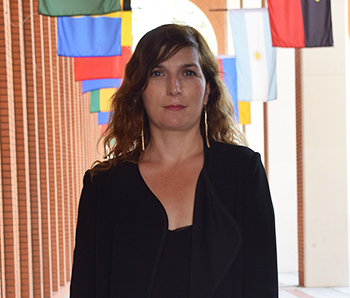
Mélanie Péron
Mélanie Péron discovered the power of personal stories the first time she was assigned to teach the Holocaust at the University of Pennsylvania. She had started out the course just trying to teach dry historical facts, and it didn’t go very well.
“It was one of the hardest experiences ever,” Péron said. “It was horrendous. My students were bored, I was scared. Finally I said, ‘We’re going to do something else.’”
Péron had each student create and write about a fictional character that lived in Paris during World War II. Suddenly, the time period began to come alive for them, and everyone, including Péron, became engaged in learning about the Holocaust.
Péron will bring survivors’ stories to the classroom again this year, following her week in residence at USC Shoah Foundation Center for Advanced Genocide Research as the 2016 Rutman Fellow for Research and Teaching. The Rutman Fellowship is open to faculty at UPenn and enables the selected fellow to conduct research at the Institute’s office in Los Angeles during the summer in preparation for incorporating the Visual History Archive into their courses.
Péron is a lecturer in the French and Francophone department at UPenn and this year will teach a brand-new course on France during the German occupation of World War II and “non-memory”: the memories of the Holocaust that are often forgotten or unknown in France.
In addition to using testimony to reinforce historical facts, Peron will connect testimony to three works about French Jews the students will be reading: the diary of Helene Berr, letters from Louise Jacobson, and a novel about Dora Bruder. All three women were about 20 during the war and all three died when they were deported from France during the occupation.
In the Visual History Archive, Péron has found testimonies of survivors who lived in Paris and share a name, similar birthday and/or neighborhood in Paris with the women in the literature. These testimonies will, she hopes, help make the stories of Helene, Louise and Dora real for her students.
“The objective of the course is to put a voice on silences in a time period when it was taboo [to speak about the occupation] for many reasons,” Péron said. “So giving a voice to written words, I think that’s what’s going to make it tangible for my students.”
The course will also include a project to create a map of key places in Paris during the occupation, which will also be informed by testimony from the Visual History Archive.
“A city has so much to tell you,” Péron said. “It’s not to turn Paris into this place of horror, it’s really to make Paris be even more touching.”
By watching testimony alongside their study of the German occupation of France, Péron hopes that her students begin to think seriously about what the Holocaust actually meant for ordinary people – not in the abstract sense of the number of people killed, but how their lives were really affected.
“I don’t think anyone really allows themselves to think about that – practically, what does it mean? If someone said don’t go home, the French police are there, where do you go?” she said. “So that’s where [testimony] is going to give this human dimension, not just the historical, statistical dimension.”